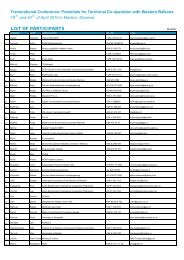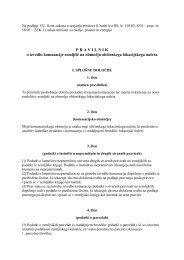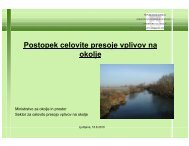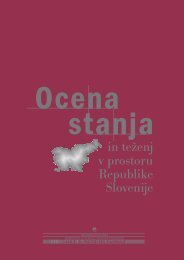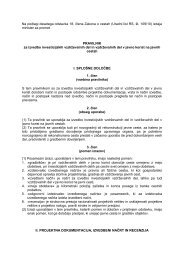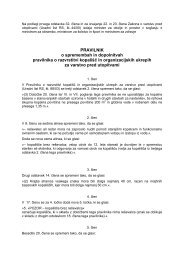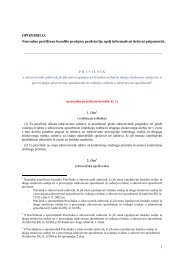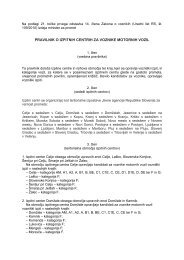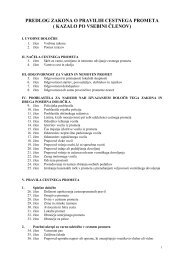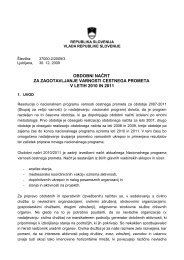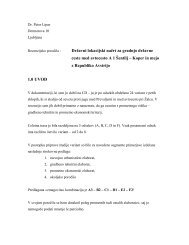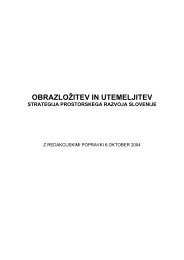evropska konvencija o krajini - Ministrstvo za infrastrukturo in prostor
evropska konvencija o krajini - Ministrstvo za infrastrukturo in prostor
evropska konvencija o krajini - Ministrstvo za infrastrukturo in prostor
You also want an ePaper? Increase the reach of your titles
YUMPU automatically turns print PDFs into web optimized ePapers that Google loves.
78Delavnica 1 / Workshop 1– strokovno okolje, ki je bolj odprto <strong>za</strong> dialog <strong>in</strong>primerjavo ter predano sodelovanje, takoupravno kot strokovno, presegajoč ovirelastne pomembnosti, ki kaznuje odnosupravnih struktur na vseh nivojih prav takokot akademski odnos, katerega pogostopreprečujejo rivalstva med različnimi šolami<strong>in</strong> strokami;– odnos eksperimentalnega <strong>in</strong> izbirnegaupravljanja, ki je sposobno pravočasnoprestreči območja sprememb znotraj kraj<strong>in</strong>e<strong>in</strong> sodelovati v njihovem preoblikovanju spomočjo <strong>in</strong>teligentne <strong>in</strong> preprečevalnekomb<strong>in</strong>acije strategij, predstavljenih s stranirazličnih vpletenih subjektov. Pri tem odnosune gre le <strong>za</strong> izvajanje tistih omejitev, ki jihnalaga oblast, pač pa <strong>za</strong> skupno izdelovanjekrajevnih list<strong>in</strong> <strong>in</strong> strateških agend, ki sozmožne spodbujati javne <strong>in</strong> <strong>za</strong>sebneprojekte, podkrepljene s postopkovnimi <strong>in</strong>f<strong>in</strong>ančnimi spodbudami.Znotraj te perspektive postaja približevanjelogike urbanizma h kraj<strong>in</strong>ski logiki osrednja tema<strong>za</strong> doseganje ciljev kakovosti kraj<strong>in</strong>e.Moja hipote<strong>za</strong> je, da bo le uč<strong>in</strong>kovita pove<strong>za</strong>vateh dveh stališč omogočila <strong>kraj<strong>in</strong>i</strong>, da postanevrednota, ki je zmožna usmerjati <strong>prostor</strong>skapreoblikovanja, namesto da jih samo pogojuje vneizbežno majhnem obsegu.Pove<strong>za</strong>va je težka, vendar ne nemogoča, kotpriča pionirsko delo peščice obč<strong>in</strong>, pri katerih n<strong>in</strong>aključje, da izhajajo iz tistih regij, ki so najboljobčutljive na izvajanje evropske konvencije.Preden pa načnem temo, kaj se lahko naučimoiz izkušenj, naj razložim posledice predlaganegapristopa.Skupni pristop urbanizma <strong>in</strong> kraj<strong>in</strong>e lahkorazumemo kot vzporedje med dvema nač<strong>in</strong>omaupravljanja sprememb: prvi je usmerjen kdiscipl<strong>in</strong>iranju razvoja naselij <strong>in</strong> rabe zemlje,medtem ko je cilj drugega skrb <strong>za</strong> ohranitevpomenov <strong>in</strong> fizičnih oblik, ki so značilne <strong>za</strong> nekokraj<strong>in</strong>o. Gre <strong>za</strong> dva pristopa, ki izhajata izrazličnih strok <strong>in</strong> ki morata obravnavati prakse <strong>in</strong><strong>in</strong>tervencijske politike, ki se opazno razlikujejo.Njuna komb<strong>in</strong>acija, osredotočena na določenokraj<strong>in</strong>o, lahko jamči, da prepoznavnost določenihstrokovnih tradicij ostaja nespremenjena.Vendar prav pojmovanje teh ciljev kakovosti kottočke obrata, tako <strong>za</strong> urbanizem kot <strong>za</strong> kraj<strong>in</strong>o,nature, tend to simultaneously consider the landscapeand the territory.In order that this advanced vision of landscapepolicies can truly affirm itself, at least three conditionsmust be matured:– the pr<strong>in</strong>cipal of the shared sovereignty of thelandscape, as part of a system of multilevelgovernance that, first and foremost, reaffirmsthe value of the landscape with<strong>in</strong> themanagement of spatial transformations;– a culture of experts that is more open todialogue and comparison and faithful cooperation,both adm<strong>in</strong>istrative and discipl<strong>in</strong>ary,overcom<strong>in</strong>g the barriers of a selfreferentialitythat penalises the behaviour of adm<strong>in</strong>istrativestructures at all level as much asacademic behaviour, often h<strong>in</strong>dered by rivalriesbetween various schools and discipl<strong>in</strong>es;– an attitude of experimental and selectivegovernment that is capable of <strong>in</strong>tercept<strong>in</strong>g,<strong>in</strong> a timely fashion, the areas of changewith<strong>in</strong> the landscape and of participat<strong>in</strong>g <strong>in</strong>their transformation through an <strong>in</strong>telligentand preventative comb<strong>in</strong>ation of the strategiespresented by the various subjects <strong>in</strong>volved.It is an attitude that entrusts, ratherthan only those restrictions imposed by authorities,the shared production of landscapecharters and strategic agendas that are capableof promot<strong>in</strong>g public and privateprojects, assisted by procedural and f<strong>in</strong>ancial<strong>in</strong>centives.With<strong>in</strong> this perspective the approximation of thelogic of urbanism to that of the landscape isbecom<strong>in</strong>g a central theme for the achievementof landscape quality objectives.The hypotheses that I am putt<strong>in</strong>g forward is thatof only an effective <strong>in</strong>tegration between thesetwo po<strong>in</strong>ts of view will allow the landscape tobecome a value that is capable of orient<strong>in</strong>g spatialtransformations, and not only to conditionthem with<strong>in</strong> an <strong>in</strong>evitably limited range.This <strong>in</strong>tegration is difficult, though not impossible,as demonstrated by the pioneer<strong>in</strong>g work ofa few Municipalities, not by chance located <strong>in</strong>those regions that are most sensitive to the applicationof the European Convention. However,before discuss<strong>in</strong>g what can be learned from experience,I would like to discuss the implicationsof the proposed approach.



